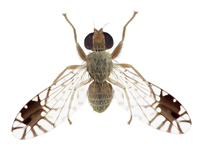Abstract
A new species of the genus Tylencholaimus, collected in natural areas of Iran, is described and illustrated, including SEM observations. Tylencholaimus discus sp. n. is characterized by its 0.65–0.76 mm long body, lip region offset by weak constriction and 7–7.5 µm broad with a conspicuous perioral disc, odontostyle 6–7 µm long, odontophore 9–10.5 µm long and visibly flanged rather than knobbed, neck 230–259 µm long with anterior region weakly muscular and basal expansion 98–125 µm long or occupying 42–49% of total neck length, female genital system mono-prodelphic, posterior branch reduced to a uterine sac 2–20 µm long or much shorter (0.1–0.6 times) than body diameter but very occasionally consisting of uterus, sphincter and a small terminal mass all together measuring 35–40 µm long, V = 65–74, tail short and rounded (13–17 µm, c = 41–57, c’ = 0.6–0.8), and male unknown.
References
Abolafia, J. & Peña-Santiago, R. (2005) Nematodes of the order Rhabditida from Andalucía Oriental: Pseudacrobeles elongatus (de Man, 1880) comb. n. Nematology, 7, 917–926.
https://doi.org/10.1163/156854105776186415
Ahad, S. & Ahmad, W. (2016) Description of two new and six known species of the genus Tylencholaimus de Man, 1876 (Nematoda: Dorylaimida) with a diagnostic compendium and key to species. Zootaxa, 4107 (4), 451–490.
https://doi.org/10.11646/zootaxa.4107.4.1
De Grisse, A.T. (1969) Redescription ou modification de quelques techniques utilisées dans l’étude des nematodes phyto-parasitaires. Mededelingen van de Rijks Faculteit Landbouwwetenschappen Gent, 34, 351–369.
Ghaderi, R., Kashi, L. & Karegar, A. (2012) The nematodes of Iran (based on the published reports until 2011). Agricultural Education and Extension Publication, Tehran, 371 pp.
Jairajpuri, M.S. & Ahmad, W. (1992) Dorylaimida.Free-living, Predaceous and Plant-parasitic Nematodes. Oxford & IBH Publishing Co. Pvt. Ltd., New Delhi, 458 pp.
Mohilal, N. & Dhanachand, C. (2003) Studies on soil nematodes of Manipur- XI: Two new and one known species of Tylencholaimus. Uttar Pradesh Journal of Zoology, 23, 87–92.
Peña-Santiago, R. (2008) The genus Tylencholaimus de Man, 1876 (Dorylaimida: Tylencholaimidae), revisited twelve years after. Journal of Nematode Morphology & Systematics, 11, 119–128.
Peña-Santiago, R. & Coomans A. (1994) Revision of the genus Tylencholaimus de Man, 1876. Prodelphic species: Part III. Nematologica, 40, 348–368.
https://doi.org/10.1163/003525994X00256
Peña-Santiago, R. & Coomans, A. (1996).Revision of the genus Tylencholaimus de Man, 1876. General discussion and key to the species. Nematologica, 40, 440–454.
Vinciguerra, M.T. (1986) New and known species of Tylencholaimus de Man, 1876 (Dorylaimida: Nematoda) from Italian beech forests with a key to the species. Nematologia Mediterranea, 14, 107–116.
Whitehead, A.G. & Hemming, J.R. (1965) A comparison of some quantitative methods of extracting small vermiform nematodes from soil. Annals of Applied Biology, 55, 25–38.
https://doi.org/10.1111/j.1744-7348.1965.tb07864.x

